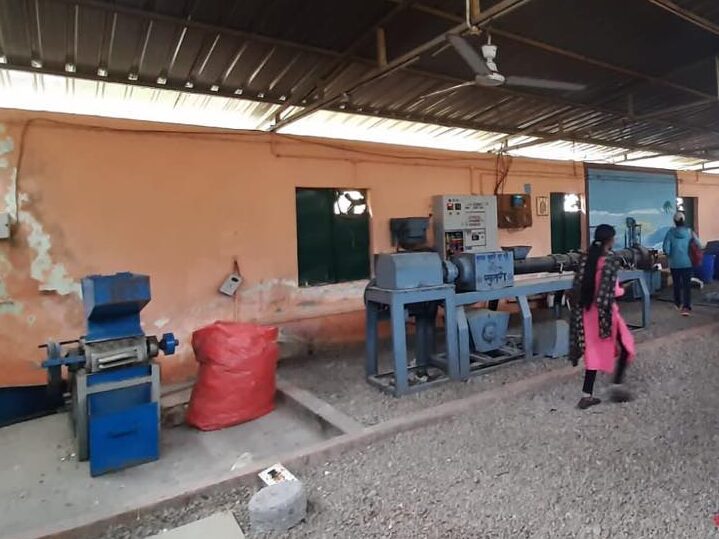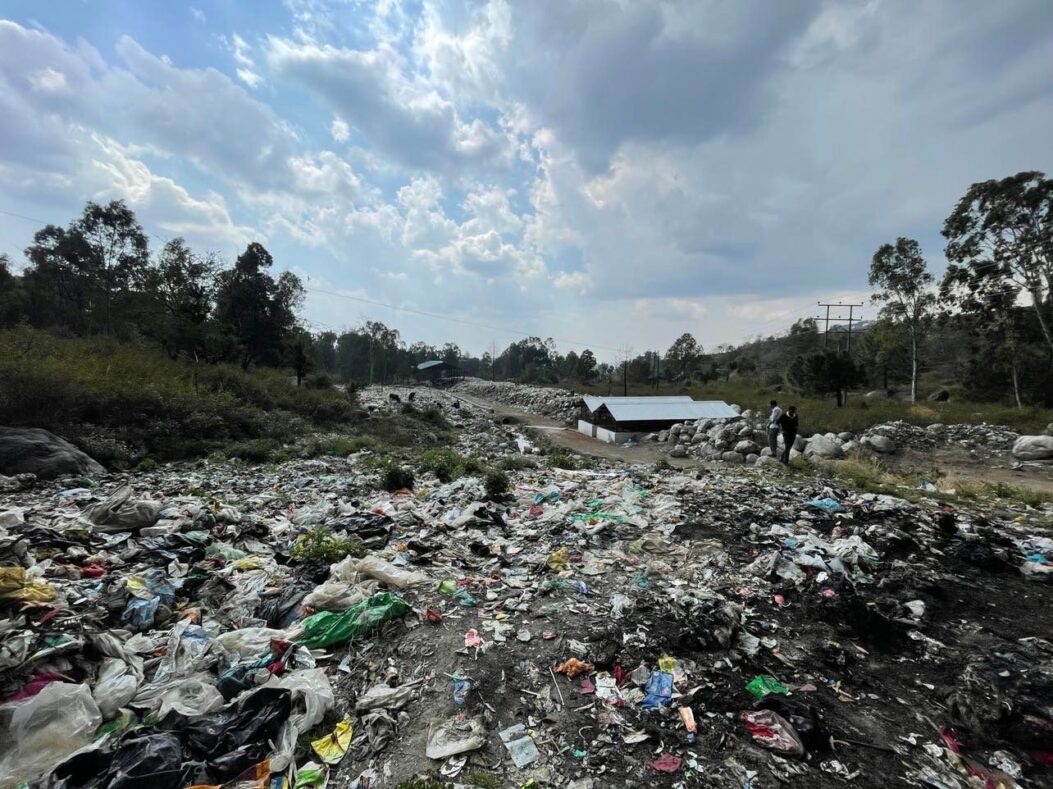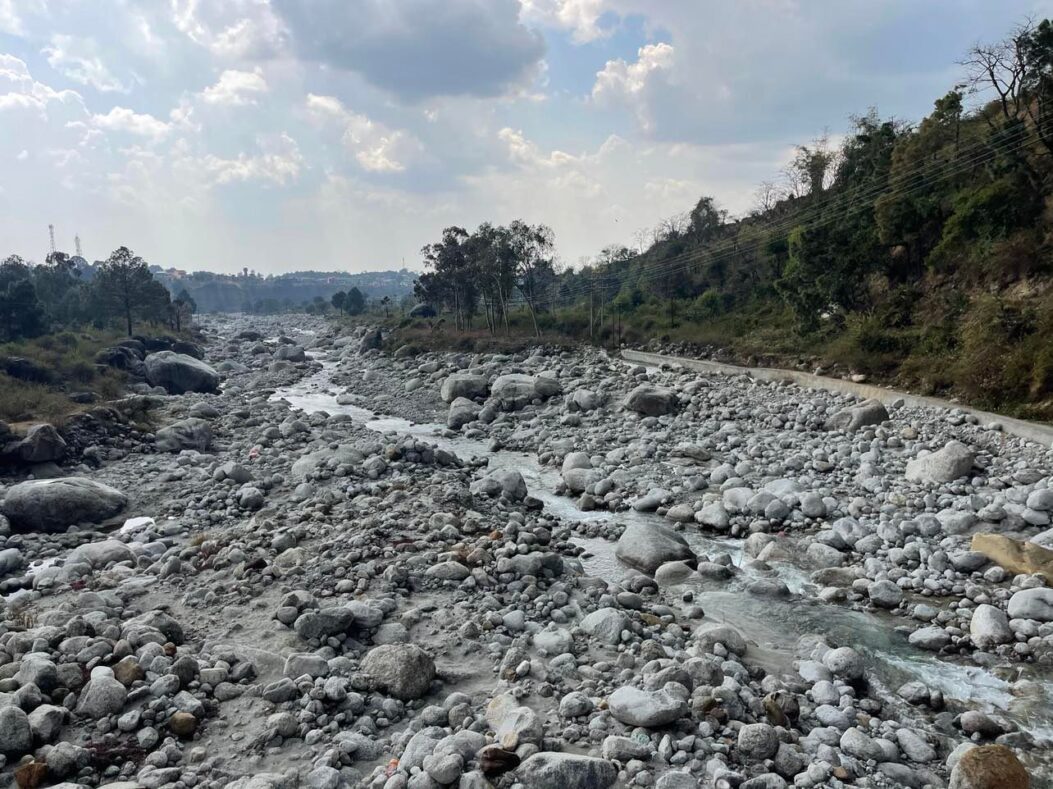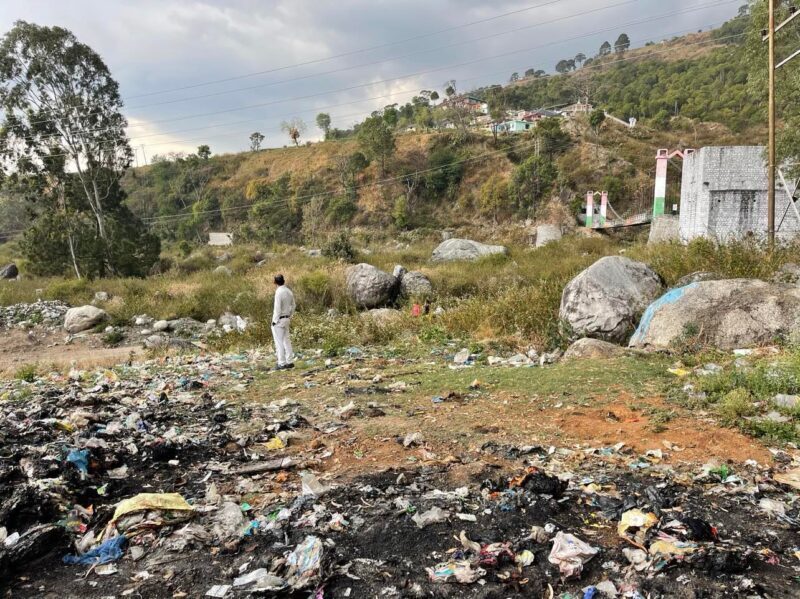When we arrived at the Aima village ‘waste processing plant’, next to Neugal khad (stream), near Palampur, Himachal Pradesh, there had just been a large downpour. The rubbish strewn all along the riverbank was drenched in dirt, likely worsening the stench – putrid, a little acidic, somehow sludge-like. We tiptoed through it to reach the centre of the operation, a room full of machines designed to break down anything from kitchen waste to plastic bottles. The only issue was, none of them were plugged in. They clearly hadn’t been in a long time.
‘Rs. One lakh, for ‘Gram Panchayat, Aima Dev. Block Bhawarna’: A giant cardboard cheque stood hidden behind some boxes, suggesting it was probably awarded at some kind of special ceremony. From Rural Development, given in 2018. Apparently, the now defunct Aima waste processing plant was once praised as a development marvel, showing “the way to effective waste management” and as an example to be emulated by its “big brothers” like Shimla. It won awards, including second place in the Himachal Pradesh Environment Leadership Awards 2018-19, and its success was expected to be emulated by other Panchayats in the state.


Today, as we observed, the only rubbish being processed here is through manual handling by a group of women waste pickers, collecting cardboard, metals and aluminium, plastic and glass bottles, plastic bags – anything that can be recycled, repurposed and/or resold. The grounds of the plant beyond them were almost nothing more than piles of rubbish, nearly as far as the eye could see. The stream rushed quietly in the distance, and as we moved closer to it, black smoke from a small rubbish fire rose up into the sky.

Himachal’s Waste Problem
The North West Himalayan state of Himachal Pradesh, like much of the rest of India, has a serious waste management problem. Despite being a majority rural state, Himachal currently generates 370 TPD (tonnes per day) of solid waste, much of it non-biodegradable (National Green Tribunal No.606/2018, hearing 16/03/2023). Official estimates indicate that 111 TPD of solid waste, or six dumper trucks per day, is landfilled, but according to an order from the National Green Tribunal, this number is likely to be higher. Large-scale government investment in infrastructure development and tourism means this number will continue to grow, but there are a lack of methods for dealing with this waste effectively, even in major cities like Dharamshala and Shimla. Tourism in particular has led to a dramatic rise in the amount of non-biodegradable waste. Total tourist inflow increased from 14.2% between 2011 and 2019, and in 2022, there were 1.51 crore visitors to the state. In fact, it is during peak tourist season in May and June when HP sees its largest amounts of waste generation.
With a recorded 57 dumping sites, most of which are in rural areas, residents are particularly at risk of the environmental and safety risks of poor waste management. Though access to safe soil and water in these areas are crucial, many dumping sites are located close by community water supplies, farmlands and forest lands. In a mountainous landscape, the dumping of waste on slopes or riverbeds means that it ultimately flows down into rivers and streams. People overwhelmingly rely on fresh – surface and ground – water for both their lives and livelihoods: drinking, bathing, cooking, farming. Water contaminated by waste has resulted in various illnesses for Himachal communities living near dumping sites, and contamination of air (due to burning) and soil pollution is another serious health as well as ecological concern.
The reality in most of Himachal and most significantly in rural areas, is that there is no other option than to burn waste. The burning of plastics is especially harmful, releasing toxic gases like dioxins, furans, mercury and polychlorinated biphenyls (BCPs) which can poison crops and waterways, damage vegetation, harm animals and cause illness, ranging from respiratory conditions to fertility issues to cancer.
However, in most rural areas the biodegradable waste is composted and there is a culture of reusing many non-degradable materials. It is when the dumping and burning becomes centralised, in and around the municipal areas and tourist zones, that the issue of desegregated waste truly becomes a danger.
Failing Waste ‘Management’
Though it is desperately required, local municpalbodies in Himachal have struggled to implement safe waste handling and management policies. The Central Pollution Control Board has ranked the state 18th for environmental performance, and has observed that in 2021 Himachal has not converted any of its dumping sites to landfill, and have not been monitoring “Waste Processing & Disposal Sites in their jurisdiction.”.This is despite claims that Himachal, alongside Goa, is processing the highest amounts of municipal solid waste scientifically at 98% in their cities.
Similarly, the municipal corporation at Palampur and the AIMA model was once hailed for its management strategies. So, what went wrong? Put simply, as Mohammad Chapalwala, Programs’ Coordinator at Sambhaavnaa Institute, explained when he took us around the site, there was a disconnect between “energy use, emissions and money”. Mohammad pointed out how one of the dormant machines, a plastic recycling extruder able to convert plastic waste into bricks, had to be plugged in at three different points and required 100-150 KW. Even when the machine was operational, there was rarely enough plastic to justify its huge use of electricity, and so it has been laying almost entirely idle for more than three years.
Though the project received more than 50 lakh in funding from various channels, the cost of running the machinery was too expensive, and required a skilled workforce the plant lacked to keep it operational. Additionally, though the plant only had the capacity to treat the waste of three panchayats, a lack of other waste management options in the area meant it was used by fifteen. By 2022, the plant had barely functioned for a day over the previous year, already little more than a dumping site. In 2023, it is nothing but. Local resident and business owner Shashi Kapoor spoke of how the site was now making it “more difficult to live”. He cited the foul odour, excessive flies and a growing fear of illness due to air and water pollution, and has collected more than 80 signatures on a petition demanding that the municipal corporation move the site.
The risk of rubbish flowing into Neugal khad, the stream next to the site which is a part of Neugal River and a tributary of the Beas river, is particularly serious, as it feeds into more than 100 water supply schemes in the Palampur and Sullah areas. Two other tributaries of the Beas, Bhiral Khud and Mol Khud, have also been affected by garbage dumping, which the IPH department uses for water supply in lower areas of Palampur. Two other waste treatment plants under the jurisdiction of the Palampur MC have similarly been abandoned with “no efforts” made to upgrade them.

Residents of neighbouring villages, now a part of the MC, have also complained of environmental hazards due to waste dumping. Despite repeated assurances that “adequate measures were being taken” and “all garbage dumps will be removed soon”, the issue has not been resolved. Under the Solid Waste Management Rules 2016, Municipal Authorities such as the Palampur MC are responsible for providing methods of “collection, storage, segregation, transportation, processing and disposal of municipal solid wastes” for their communities, and these methods have to remain in accordance with the 2016 legislation. This means, for example, that the waste cannot be disposed of in “water bodies” and that it must be segregated into “three separate streams namely bio-degradable, non biodegradable and domestic hazardous wastes” which includes a handover to “authorised waste pickers or waste collectors”. This leaves the Palampur MC in violation of duties to its citizens.
Whose waste is it anyway?
However, this is not the straightforward story of a government body simply failing its people and polluting the environment. That would mean the solution was simple, and unfortunately it is nothing of the sort. Although the dumping site at Aima clearly needs to be moved away from Neugal’s banks and far from people’s water supply, the issue of where to move it to remains. Across the state Municipal Corporations are struggling with availability of land for setting up any kind of ‘waste management units’. has little available land, Understandably rural residents are unwilling to part with precious commons, grazing and forest lands for dumping sites.
To establish (or rebuild) waste management plants which operate in an environmentally and economically sustainable way unfortunately requires more money, space and training. It is of course possible that these resources be procured, and involvement of citizens as well as marginalised communities working with waste in every aspect of the waste cycle – from choosing products with less plastic to segregating at the source to demanding adherence to the Solid Waste Management Rules from local government bodies – is a powerful instigator for change and more than just a step in the right direction.
In alliance with this, a recent order from the National Green Tribunal, though it lays out many recommendations for implementation of the Solid Waste Management Rules and requires six-monthly progress reports, maintains that the responsibility for the execution of these rules falls squarely on the shoulders’ of the community.
It is evident that the issue of ‘waste’ is structural, calling for political and structural solutions – much harder to implement than technological quick-fixes like the purchasing of a kitchen waste composter. Increases in tourism, infrastructure development, consumer waste – in the very ways we place pressure on our environment – aren’t going away. Things will get worse if we look at cases like the Aima plant and and choose not to learn from them. It will require reexamining how we consume and why, which is difficult, but it is clear that the price of the alternative is much too high.
Written and Compiled by Zoe Jayne, a volunteer with Himdhara Environment Research and Action Collective. All photos taken by the author.






